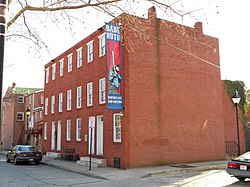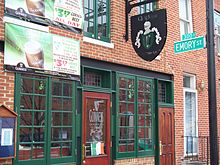
Oriole Park at Camden Yards, commonly known as Camden Yards, is a baseball stadium in Baltimore, Maryland. It is the home ballpark of Major League Baseball's Baltimore Orioles, and the first of the "retro" major league ballparks constructed during the 1990s and early 2000s. It was completed in 1992 to replace Memorial Stadium. The stadium is in downtown Baltimore, a few blocks west of the Inner Harbor in the Camden Yards Sports Complex.

The Inner Harbor is a historic seaport, tourist attraction, and landmark in Baltimore, Maryland. It was described by the Urban Land Institute in 2009 as "the model for post-industrial waterfront redevelopment around the world". The Inner Harbor is located at the mouth of Jones Falls, creating the wide and short northwest branch of the Patapsco River. The district includes any water west of a line drawn between the foot of President Street and the American Visionary Art Museum.

Baltimore Memorial Stadium was a multi-purpose stadium in Baltimore, Maryland, United States, that formerly stood on 33rd Street on an oversized block officially called Venable Park, a former city park from the 1920s. The site was bound by Ellerslie Avenue to the west, 36th Street to the north, and Ednor Road to the east.

Interstate 395 (I-395) is an auxiliary Interstate Highway in the US state of Maryland. Known as Cal Ripken Way, the highway runs 1.98 miles (3.19 km) from I-95 north to Howard Street and Camden Street in Downtown Baltimore, where it provides access to the Inner Harbor and the Baltimore Convention Center. The Interstate also serves the Camden Yards Sports Complex, which contains M&T Bank Stadium and Oriole Park at Camden Yards, homes of the Baltimore Ravens and Baltimore Orioles, respectively. I-395 also serves as the southern terminus of Martin Luther King Jr. Boulevard, an urban arterial that provides a western bypass of Downtown Baltimore and connects I-95 with U.S. Route 40 (US 40), US 1, and I-83. The Interstate is maintained by the Maryland Transportation Authority (MDTA) and, like all Interstates, is a part of the National Highway System.

"Pigtown", also known as "Washington Village" is a neighborhood in the southwest area of Baltimore, bordered by Martin Luther King Jr. Boulevard to the east, Monroe Street to the west, Russell Street to the south, and West Pratt Street to the north. The neighborhood acquired its name during the second half of the 19th century, when the area was the site of butcher shops and meat packing plants to process pigs transported from the Midwest on the B&O Railroad; they were herded across Ostend and Cross Streets to be slaughtered and processed.
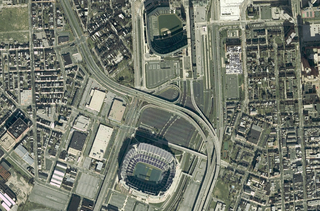
The Camden Yards Sports Complex is located in the center of Baltimore, Maryland. The complex is composed of multiple buildings and stadiums including Oriole Park at Camden Yards and M&T Bank Stadium. The two stadiums are home to the Baltimore Orioles of Major League Baseball and the Baltimore Ravens of the National Football League. The Babe Ruth Birthplace and Museum is located approximately two blocks from the main entrance of Camden Yards at Eutaw Street. The complex also features the original Camden Station which formerly housed the Sports Legends Museum at Camden Yards and Geppi's Entertainment Museum. In addition to the sports facilities, it is also a location for community events such as the Dew Tour's Panasonic Open in June 2007 and 2008, the Baltimore Marathon, and the African American Festival which is held every year.

Sports Legends Museum at Camden Yards was a non-profit sports museum in Baltimore, Maryland. The museum is owned and operated by the Babe Ruth Birthplace and Museum. It opened on May 14, 2005, with Julia Ruth Stevens, the daughter of celebrated baseball player Babe Ruth, in attendance. The 22,000-square-foot (2,044 m2) museum, housed in the former Camden Station, was adjacent to the main gate of Oriole Park at Camden Yards and had artifacts and interactive exhibits profiling Maryland's sports history. Exhibits included such area teams as the Baltimore Orioles, Baltimore Ravens, Baltimore Colts, Maryland Terrapins, Baltimore Elite Giants, Baltimore Black Sox, and the Baltimore Blast.

Col. Charles Ridgely II, "Charles The Merchant" (1702–1772), of "Ridgely's Whim", was a Justice, planter, merchant, ironmaster, and member of the General Assembly of Maryland's lower chamber, House of Delegates and one of Baltimore County's commissioners. Charles II was the son of Charles Ridgely I,, , and Deborah Dorsey, daughter of Hon. John Dorsey.
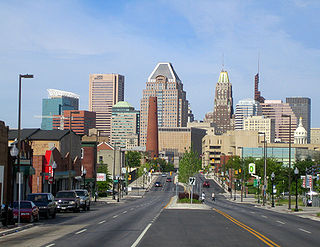
Downtown Baltimore is the central business district of the city of Baltimore traditionally bounded by Martin Luther King, Jr. Boulevard to the west, Franklin Street to the north, President Street to the east and the Inner Harbor area to the south.
The 1992 Baltimore Orioles season was a season in American baseball. It involved the Orioles finishing third in the American League East with a record of 89 wins and 73 losses.

The Coldstream-Homestead-Montebello community, often abbreviated to C-H-M, is a neighborhood in northeastern Baltimore, Maryland. A portion of the neighborhood has been listed on the National Register of Historic Places as the Coldstream Homestead Montebello Historic District, recognized for the development of a more suburban style of rowhouses.

Ednor Gardens-Lakeside is a large community in northeast Baltimore, Maryland. It is bounded by 33rd Street to the south, Hillen Road to the east, Ellerslie Avenue to the west, and Argonne Drive, The Alameda, Loch Raven Boulevard, and Roundhill Road to the north. Ednor Gardens was part of a large planned community that was built out from the 1920s through the 1950s by Edward Gallagher, one of Baltimore's most prolific homebuilders at the time. It is notable among its neighbors for the quality of the homes and extensive landscaping. Until it was torn down in 2002, Memorial Stadium was located in Ednor Gardens-Lakeside.
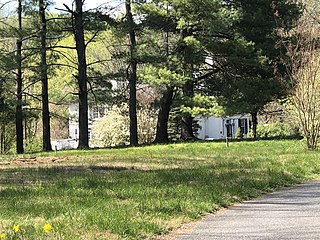
The Commodore Joshua Barney House is a historic home located at Savage, Howard County, Maryland, United States. It was originally situated on a 700-acre tract in modern Savage Maryland named Harry's Lot, at a time when the closest town was Elk Ridge. Both "Haary's Lot" and "Huntington Quarter" were inherited by Charles Greenberry Ridgely, sixth son of Colonel Henry Ridgley and Elizabeth Warfield Ridgley. After the death of Charles Greenberry Ridgely, Thomas Coale purchased portions of the land containing the structure. His daughter would become the famous Commodore Joshua Barney's second wife, bringing the figure from business in Baltimore. In 1809, Nathaniel F. Williams (1782-1864) married Caroline Barney, daughter of Joshua Barney, who in turn expanded an existing mill site on the property to create the Savage Mill.
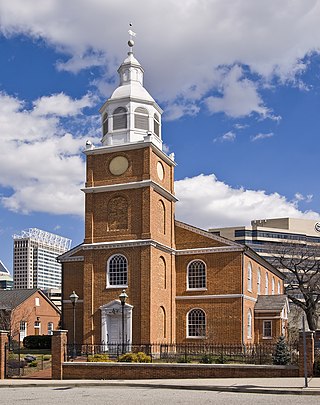
Otterbein Church, now known as Old Otterbein United Methodist Church, is a historic United Brethren church located in Baltimore, Maryland, United States. The first "German Reformed" church was built to serve the German Reformed and some Evangelical Lutheran immigrants, and later entered the Brethren strain of German Reformed Protestantism in the later Church of the United Brethren in Christ.

Babe's Dream is a 1995 bronze statue of Babe Ruth, by Susan Luery. It is located at West Camden Street and South Eutaw Street, at Oriole Park at Camden Yards, Baltimore.
The Baltimore Orioles Hall of Fame is a team Hall of Fame dedicated to representing the most significant contributors to the history of the Baltimore Orioles professional baseball team since the first season of Baltimore baseball in 1954, which has inducted players, managers, staff, and other contributors. The Hall of Fame is on display at Oriole Park at Camden Yards in Baltimore, Maryland.

Stadium Area is a neighborhood in south Baltimore, Maryland. The area is largely consistent of adjacent sports stadiums, M&T Bank Stadium and Oriole Park at Camden Yards, and the surrounding infrastructure supporting them.

The Babe Ruth Birthplace and Museum is a row house located at 216 Emory Street, in Baltimore, Maryland, where baseball legend Babe Ruth was born. The property was restored and opened to the public in 1974 by the Babe Ruth Birthplace Foundation, a non-profit organization.
